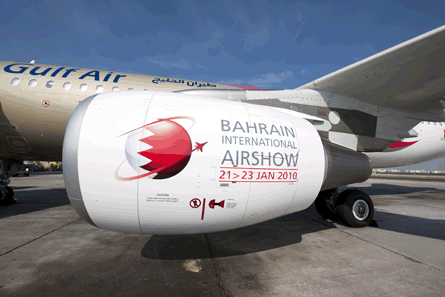Among the obstacles facing Bahraini flag carrier Gulf Air as it embarks on its latest restructuring is the presence of a rival airline that did not exist at the time of its previous efforts to overhaul its strategy.
There are signs that Bahrain Air, barely two years old, will commit to expanding its Airbus A320-family fleet at the kingdom's air show this week. Airbus data shows that the airline has 10 A319s and A320s.
Bahrain Air began services in February 2008, three months after Gulf Air switched from a cautious scaling-back of operations and opted to pursue an ambitious expansion programme - a plan that is being heavily amended following an extensive review late in 2009.
 |
|---|
© Gulf AirGulf Air is a sponsor of the show |
IRAQ SERVICES
Despite proclaiming it would not compete with Gulf Air, almost all points on its network of 20 destinations are also served by the flag carrier. Just days after Gulf Air unveiled plans to open services to Iraq, Bahrain Air disclosed that it would also start operating Iraqi flights.
How this claustrophobic relationship will play out between the two carriers, which share a base in the smallest of the Middle Eastern states, is likely to depend on Gulf Air's new strategy of pursuing regional destinations.
New chief executive Samer Majali's wide-ranging review of Gulf Air's business, undertaken to halt its staggering losses, has concluded that the carrier needs to move away from a head-to-head battle with competitors.
That competition not only includes the rivalry with the major hubs of Emirates, Etihad Airways and Qatar Airways, but also increased activity from the budget sector in Bahrain.
Kuwait's Jazeera Airways turned its attention to Bahrain last year after encountering problems developing its base at Dubai. Sharjah's Air Arabia already serves Bahrain and the United Arab Emirates' newest low-cost operator, FlyDubai, began flying to the kingdom in mid-December. Primary airports in the region are "very well served", says Majali: "But there are underserved secondary airports."
His review of Gulf Air included assessing four alternative directions in which to take the airline. Efficiency measures and the cutting of poorly performing routes were deemed insufficient, because the review concluded that Gulf Air needed overhauling at its core.
The other options addressed this need for "radical" change, says Majali. Gulf Air considered following an approach similar to that of other major airlines in the region, relying heavily on transit traffic and using a mix of long-haul and short-haul aircraft to take passengers via Bahrain, but determined that this model bore too much risk. Transit passengers would "add little" to the Bahraini economy, Majali points out, adding that they "continue to drive the price-discounting model".
Gulf Air believes its needs are better served by concentrating on regional routes with a simplified fleet based on smaller aircraft types. The A320 is at the forefront of its near-term plans. It has also disclosed plans to lease regional jets to serve thinner routes, with an initial deal for four to six expected this year.
"Gulf Air has the largest Middle Eastern network of flights and destinations," says Majali. "Our strategy further supports this."
Concentration on smaller aircraft will affect the airline's heavy order backlog for long-haul jets. Although Gulf Air has yet to reveal the extent of any amendment, its commitment to the Boeing 787 and its preference for smaller Airbus jets has made its order for 20 A330s appear vulnerable. It is phasing out its nine A340s, and has already sold two of them.
Source: Flight International























